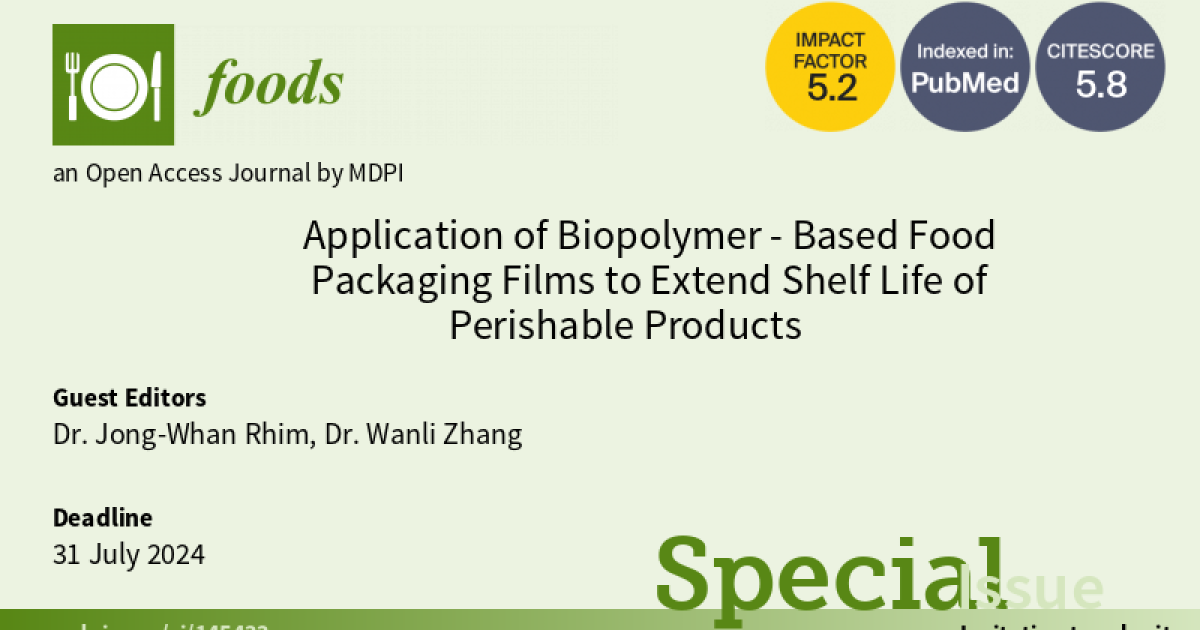Application of Biopolymer-Based Food Packaging Films to Extend Shelf Life of Perishable Products
A special issue of Foods (ISSN 2304-8158). This special issue belongs to the section "Food Packaging and Preservation".
Deadline for manuscript submissions: closed (31 July 2024) | Viewed by 16196

Special Issue Editors
Interests: sustainable biopolymers; bionanocomposite materials; antibacterial food packaging; active food packaging
Special Issues, Collections and Topics in MDPI journals
Interests: post-harvest fruit physiology; fresh product preservation; biodegradable food packaging films; food packaging film performance enhancement technology
Special Issues, Collections and Topics in MDPI journals
Special Issue Information
Dear Colleagues,
In people’s daily diets, fresh fruits, vegetables, poultry, seafood and cheese are perishable. Food packaging films can extend the shelf life of perishable products by providing protection and barriers. In recent years, the non-degradable nature of petroleum-based plastic food packaging film has caused some serious environmental problems. In addition, many studies have focused on the entry of microplastic particles in food into human tissues caused by plastic food packaging, which may cause adverse health effects. Therefore, the design and development of biopolymer-based food packaging materials represent a current imperative for the food industry. Sustainable biopolymer molecules with good film-forming properties, such as proteins, polysaccharides, microorganisms and chemically derived materials, are being used to develop food packaging materials and have shown promising food preservative results. Thus, the aim of this Special Issue is to provide readers with an extensive overview of the recent developments and advancements in biopolymer-based food packaging films in extending the shelf life of perishable products. Therefore, we cordially invite authors to contribute original research articles and reviews.
Prof. Dr. Jong-Whan Rhim
Dr. Wanli Zhang
Guest Editors
Manuscript Submission Information
Manuscripts should be submitted online at www.mdpi.com by registering and logging in to this website. Once you are registered, click here to go to the submission form. Manuscripts can be submitted until the deadline. All submissions that pass pre-check are peer-reviewed. Accepted papers will be published continuously in the journal (as soon as accepted) and will be listed together on the special issue website. Research articles, review articles as well as short communications are invited. For planned papers, a title and short abstract (about 100 words) can be sent to the Editorial Office for announcement on this website.
Submitted manuscripts should not have been published previously, nor be under consideration for publication elsewhere (except conference proceedings papers). All manuscripts are thoroughly refereed through a single-blind peer-review process. A guide for authors and other relevant information for submission of manuscripts is available on the Instructions for Authors page. Foods is an international peer-reviewed open access semimonthly journal published by MDPI.
Please visit the Instructions for Authors page before submitting a manuscript. The Article Processing Charge (APC) for publication in this open access journal is 2900 CHF (Swiss Francs). Submitted papers should be well formatted and use good English. Authors may use MDPI's English editing service prior to publication or during author revisions.
Keywords
- sustainability
- biopolymer
- food packaging
- shelf life
- perishable products
Benefits of Publishing in a Special Issue
- Ease of navigation: Grouping papers by topic helps scholars navigate broad scope journals more efficiently.
- Greater discoverability: Special Issues support the reach and impact of scientific research. Articles in Special Issues are more discoverable and cited more frequently.
- Expansion of research network: Special Issues facilitate connections among authors, fostering scientific collaborations.
- External promotion: Articles in Special Issues are often promoted through the journal's social media, increasing their visibility.
- e-Book format: Special Issues with more than 10 articles can be published as dedicated e-books, ensuring wide and rapid dissemination.
Further information on MDPI's Special Issue polices can be found here.







